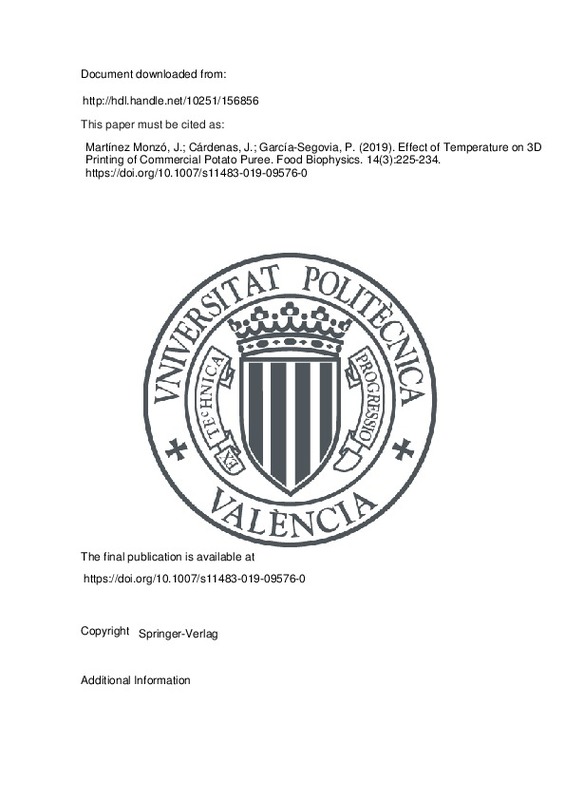G. Ares, A. Giménez, A. Gámbaro, Instrumental methods to characterize nonoral texture of dulce de leche. J. Texture Stud. 37(5), 553–567 (2006). https://doi.org/10.1111/j.1745-4603.2006.00068.x
S. Bhattacharya, N. Vasudha, K.S. Krishna Murthy, Rheology of mustard paste: A controlled stress measurement. J. Food Eng. 41(3), 187–191 (1999). https://doi.org/10.1016/S0260-8774(99)00102-8
F. Chuanxing, W. Qi, L. Hui, Z. Quancheng, M. Wang, Effects of pea protein on the properties of potato starch-based 3D printing materials. Int. J. Food Eng. 14(3), 1–10 (2018). https://doi.org/10.1515/ijfe-2017-0297
[+]
G. Ares, A. Giménez, A. Gámbaro, Instrumental methods to characterize nonoral texture of dulce de leche. J. Texture Stud. 37(5), 553–567 (2006). https://doi.org/10.1111/j.1745-4603.2006.00068.x
S. Bhattacharya, N. Vasudha, K.S. Krishna Murthy, Rheology of mustard paste: A controlled stress measurement. J. Food Eng. 41(3), 187–191 (1999). https://doi.org/10.1016/S0260-8774(99)00102-8
F. Chuanxing, W. Qi, L. Hui, Z. Quancheng, M. Wang, Effects of pea protein on the properties of potato starch-based 3D printing materials. Int. J. Food Eng. 14(3), 1–10 (2018). https://doi.org/10.1515/ijfe-2017-0297
I. Dankar, M. Pujolà, F. El Omar, F. Sepulcre, A. Haddarah, Impact of mechanical and microstructural properties of potato puree-food additive complexes on extrusion-based 3D printing. Food Bioprocess Technol. 11(11), 2021–2031 (2018). https://doi.org/10.1007/s11947-018-2159-5
A. Derossi, R. Caporizzi, D. Azzollini, C. Severini, Application of 3D printing for customized food. A case on the development of a fruit-based snack for children. J. Food Eng. 220, 65–75 (2018). https://doi.org/10.1016/j.jfoodeng.2017.05.015
F.C. Godoi, S. Prakash, B.R. Bhandari, 3d printing technologies applied for food design: Status and prospects. J. Food Eng. 179, 44–54 (2016). https://doi.org/10.1016/j.jfoodeng.2016.01.025
C.A. Hamilton, G. Alici, M. in het Panhuis, 3D printing vegemite and marmite: Redefining “breadboards”. J. Food Eng. 220, 83–88 (2018). https://doi.org/10.1016/j.jfoodeng.2017.01.008
S. Holland, T. Foster, W. MacNaughtan, C. Tuck, Design and characterisation of food grade powders and inks for microstructure control using 3D printing. J. Food Eng. 220, 12–19 (2018). https://doi.org/10.1016/j.jfoodeng.2017.06.008
H.W. Kim, H. Bae, H.J. Park, Classification of the printability of selected food for 3D printing: Development of an assessment method using hydrocolloids as reference material. J. Food Eng. 215, 23–32 (2017). https://doi.org/10.1016/j.jfoodeng.2017.07.017
C. Le Tohic, J.J. O’Sullivan, K.P. Drapala, V. Chartrin, T. Chan, A.P. Morrison, et al., Effect of 3D printing on the structure and textural properties of processed cheese. J. Food Eng. 220, 56–64 (2018). https://doi.org/10.1016/j.jfoodeng.2017.02.003
M. Lille, A. Nurmela, E. Nordlund, S. Metsä-Kortelainen, N. Sozer, Applicability of protein and fiber-rich food materials in extrusion-based 3D printing. J. Food Eng. 220, 20–27 (2018). https://doi.org/10.1016/j.jfoodeng.2017.04.034
H. Lipson, M. Kurman, Fabricated: The New World of 3D Printing (John Wiley and Sons, Inc, New York, 2013)
J.I. Lipton, Printable food: The technology and its application in human health. Curr. Opin. Biotechnol. 44, 198–201 (2017). https://doi.org/10.1016/j.copbio.2016.11.015
Z. Liu, M. Zhang, B. Bhandari, Y. Wang, 3D printing: Printing precision and application in food sector. Trends Food Sci. Technol. 69, 83–94 (2017a, September). https://doi.org/10.1016/j.tifs.2017.08.018
Liu, Z., Zhang, M., Bhandari, B., & Yang, C. (2017b). Impact of Rheological Properties of Mashed Potatoes on 3D Printing. https://doi.org/10.1016/j.jfoodeng.2017.04.017
Z. Liu, M. Zhang, B. Bhandari, C. Yang, Impact of rheological properties of mashed potatoes on 3D printing. J. Food Eng. 220, 76–82 (2018a). https://doi.org/10.1016/j.jfoodeng.2017.04.017
Z. Liu, M. Zhang, C.h. Yang, Dual extrusion 3D printing of mashed potatoes/strawberry juice gel. Lwt 96(February), 589–596 (2018b). https://doi.org/10.1016/j.lwt.2018.06.014
S. Mantihal, S. Prakash, F.C. Godoi, B. Bhandari, Optimization of chocolate 3D printing by correlating thermal and flow properties with 3D structure modeling. Innovative Food Sci. Emerg. Technol. 44(September), 21–29 (2017). https://doi.org/10.1016/j.ifset.2017.09.012
F. Ronda, S. Pérez-Quirce, A. Angioloni, C. Collar, Impact of viscous dietary fibres on the viscoelastic behaviour of gluten-free formulated rice doughs: A fundamental and empirical rheological approach. Food Hydrocoll. 32(2), 252–262 (2013). https://doi.org/10.1016/j.foodhyd.2013.01.014
C. Severini, A. Derossi, D. Azzollini, Variables affecting the printability of foods: Preliminary tests on cereal-based products. Innov. Food Sci. Emerg. Technol. 38, 281–291 (2016). https://doi.org/10.1016/j.ifset.2016.10.001
C. Severini, A. Derossi, I. Ricci, R. Caporizzi, A. Fiore, Printing a blend of fruit and vegetables. New advances on critical variables and shelf life of 3D edible objects. J. Food Eng. 220, 89–100 (2018). https://doi.org/10.1016/j.jfoodeng.2017.08.025
J.R. Stokes, J.H. Telford, Measuring the yield behaviour of structured fluids. J. Non-Newtonian Fluid Mech. 124(1–3 SPEC. ISS), 137–146 (2004). https://doi.org/10.1016/j.jnnfm.2004.09.001
J. Sun, Z. Peng, W. Zhou, J.Y.H. Fuh, G.S. Hong, A. Chiu, A review on 3D printing for customized food fabrication. Procedia Manufacturing 1, 308–319 (2015). https://doi.org/10.1016/j.promfg.2015.09.057
J. Sun, W. Zhou, L. Yan, D. Huang, L.y. Lin, Extrusion-based food printing for digitalized food design and nutrition control. J. Food Eng. 220, 1–11 (2018). https://doi.org/10.1016/j.jfoodeng.2017.02.028
F. Yang, M. Zhang, B. Bhandari, Recent development in 3D food printing. Crit. Rev. Food Sci. Nutr. 57(14), 3145–3153 (2017). https://doi.org/10.1080/10408398.2015.1094732
F. Yang, M. Zhang, B. Bhandari, Y. Liu, Investigation on lemon juice gel as food material for 3D printing and optimization of printing parameters. LWT Food Sci. Technol. 87, 67–76 (2018). https://doi.org/10.1016/j.lwt.2017.08.054
M. Zhang, A. Vora, W. Han, R.J. Wojtecki, H. Maune, A.B.A. Le, et al., Dual-responsive hydrogels for direct-write 3D printing. Macromolecules 48(18), 6482–6488 (2015). https://doi.org/10.1021/acs.macromol.5b01550
L. Zhang, Y. Lou, M.A.I. Schutyser, 3D printing of cereal-based food structures containing probiotics. Food Struct. 18(August), 14–22 (2018). https://doi.org/10.1016/j.foostr.2018.10.002
[-]







![[Cerrado]](/themes/UPV/images/candado.png)


